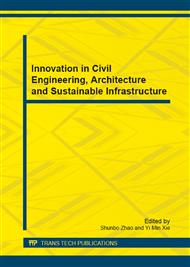p.75
p.79
p.83
p.87
p.91
p.96
p.101
p.105
p.109
Experimental Study on Mechanical Behavior of Concrete Loading along Path (Constant Stress, Constant Strain, Increasing Strain)
Abstract:
Triaxial compressive experiments were performed with normal concrete by using the large triaxial test system. The loading process was divided into two stages: (1) Under the condition of keeping the three axial stresses equivalent, the compressive stress was increased to a specified value p, which was maintained for a period of time; (2) The strain in y direction was increased monotonously while the stress in x direction and the strain in z direction both remained constant. In this paper, the study on the experiments indicates: the minimum principal stress significantly influences the strength of concrete, i.e., the greater the minimum principal stress is, the greater the concrete strength is; the stress in y direction where the strain stayed constant is the middle principal stress; the constant strain influences the relationship between σ2 and σ1, they reach the peak values at the same time and approximate to linear relationships in much parts of their descending stage, curvature only appears at their ends; When ε13>8, each relationship curve of τ13-γ13 gradually becomes horizontal;Below a line AB in figure of coordinate system εx, εy the curves of εx-εy approximately parallel to each other; If the minimum principal stress is 15MPa or 20MPa, After εkk reaches the peak point, the volume gradually becomes stable after a transient decrease stage.
Info:
Periodical:
Pages:
91-95
Citation:
Online since:
November 2012
Authors:
Keywords:
Price:
Сopyright:
© 2012 Trans Tech Publications Ltd. All Rights Reserved
Share:
Citation:


